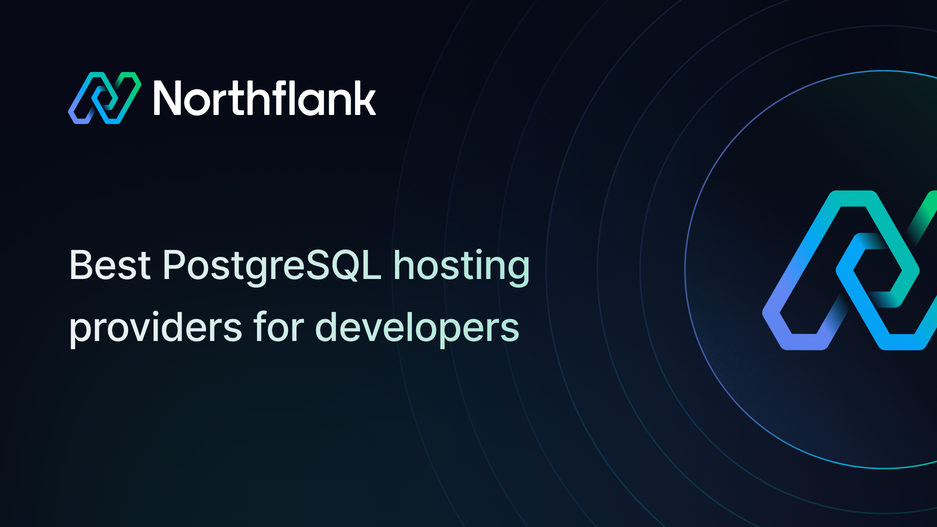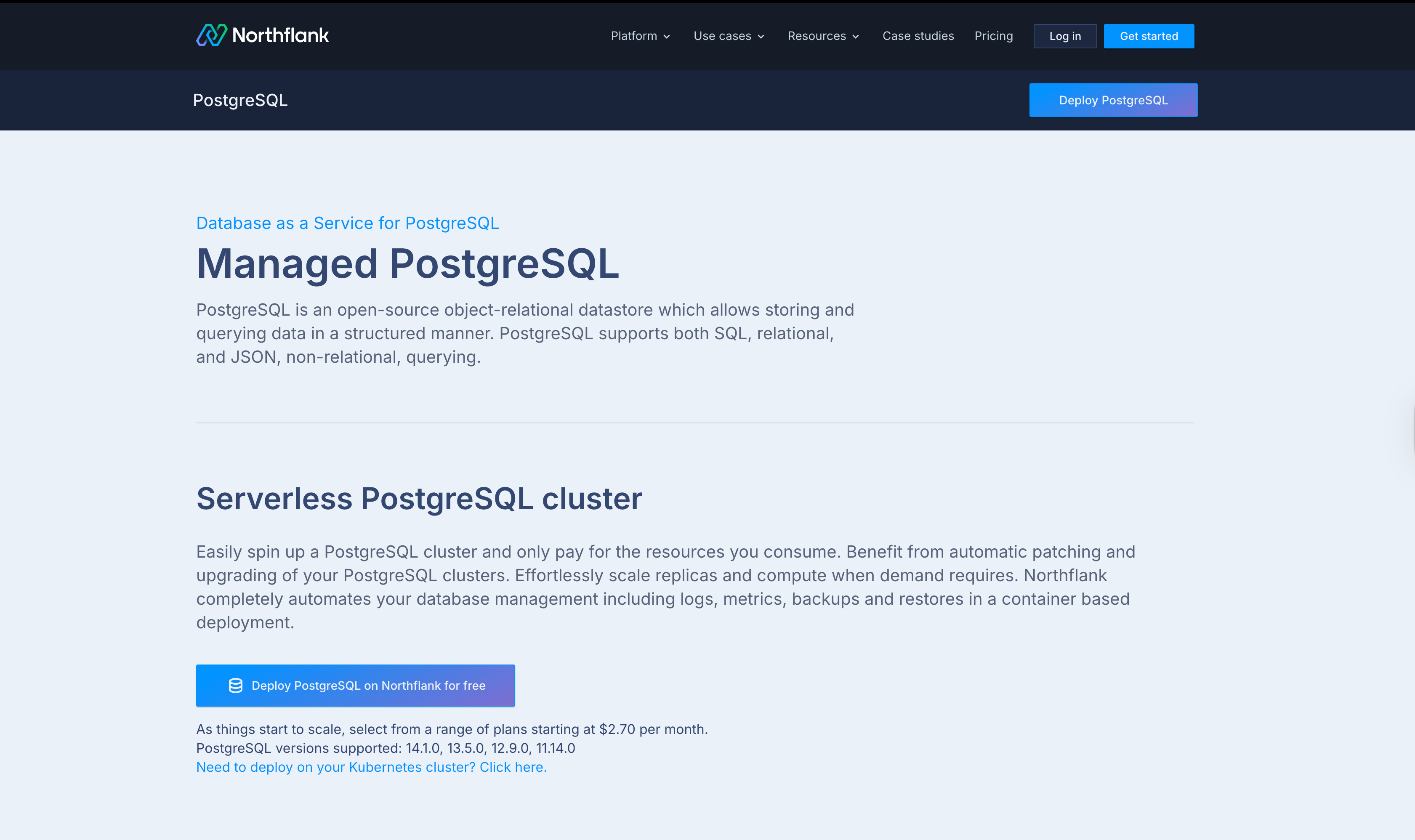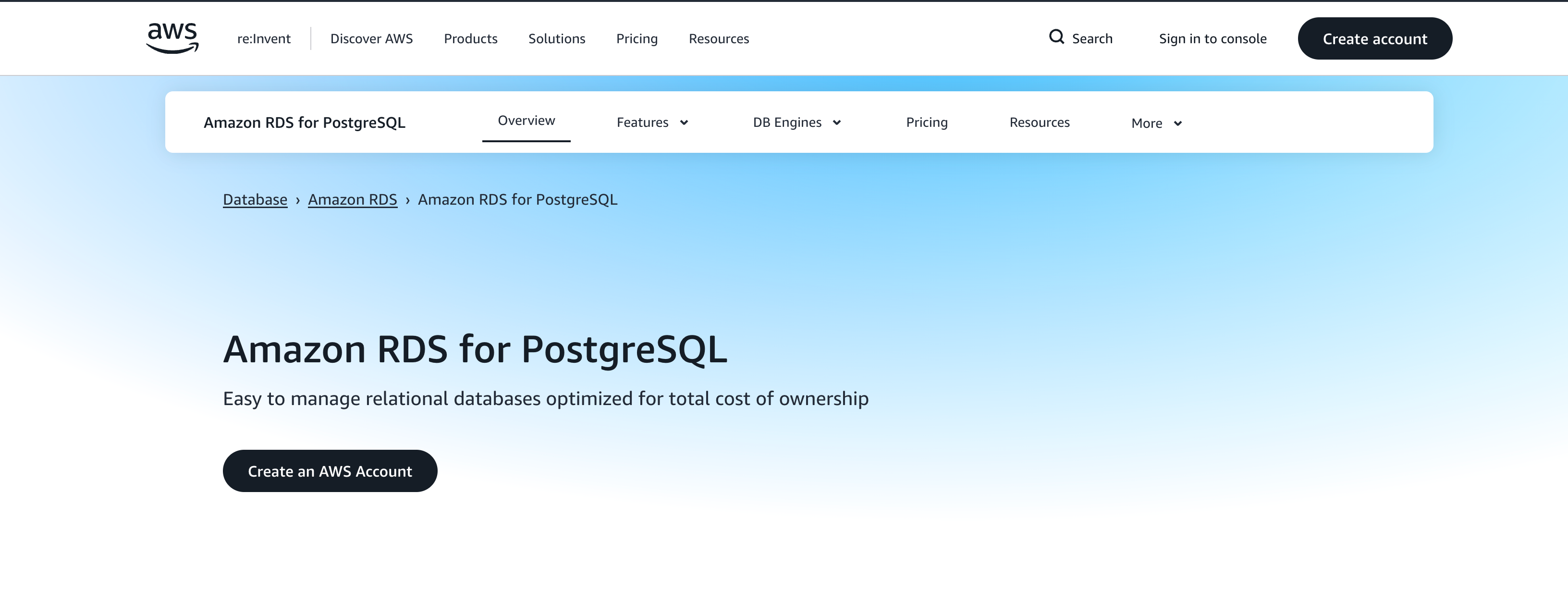

Best PostgreSQL hosting providers for developers in 2025
Choosing the right PostgreSQL hosting provider can make or break your application's performance and your development workflow.
If you're building a side project, launching a startup, or managing production databases at scale, the hosting provider you choose affects everything from deployment speed to long-term costs.
This guide compares the leading PostgreSQL hosting options in 2025, focusing on what developers prioritize: pricing, performance, developer experience, and scalability.
- Northflank - Managed PostgreSQL that deploys alongside your applications, APIs, and background services on one platform. Offers fast deployments in minutes, preview environments for testing, BYOC (Bring Your Own Cloud) support, built-in observability, and team collaboration features. For production SaaS applications and development teams.
- Neon - Serverless PostgreSQL with automatic scale-to-zero and database branching. For variable workloads and development environments.
- Supabase - PostgreSQL bundled with authentication, real-time subscriptions, and auto-generated APIs. For MVPs and rapid prototyping.
- Render - Managed PostgreSQL with simple setup. For developers wanting straightforward database hosting.
- DigitalOcean - Managed databases with predictable monthly pricing. For teams already using DigitalOcean infrastructure.
- AWS RDS - Enterprise-grade PostgreSQL with extensive configuration options. For complex requirements and AWS-native workloads.
Before comparing specific providers, consider what's most important when evaluating PostgreSQL hosting:
- Deployment speed: How quickly can you get a production-ready database running? The best providers offer deployment in minutes, not hours.
- Pricing transparency: Look for clear costs without hidden fees. Watch out for separate charges for backups, I/O operations, and data transfer that can inflate your bill.
- Free tier availability: Essential for testing, development environments, and small projects. A good free tier lets you evaluate the platform without commitment.
- Developer experience: CLI tools, APIs, and integration capabilities matter. The easier it is to deploy and manage databases programmatically, the faster your team ships.
- Scalability options: You need both vertical scaling (more CPU/RAM) and horizontal scaling (read replicas). Consider how easy it is to scale up as your application grows.
- High availability: Look for uptime guarantees, automated failover, and multi-zone deployments. Production databases need redundancy.
- Observability: Built-in monitoring, logs, and metrics help you catch issues before they impact users. External monitoring tools add complexity and cost.
- Backup and recovery: Automated daily backups are standard, but point-in-time recovery (PITR) is crucial for production workloads.
We'll review the top PostgreSQL hosting providers based on deployment speed, developer experience, pricing, and production-readiness.
Northflank provides database hosting as part of a complete application platform where you can deploy your PostgreSQL database alongside your applications, background jobs, and Redis instances.

Why Northflank for PostgreSQL:
- Lightning-fast deployment: Deploy production-ready PostgreSQL in seconds to minutes. No lengthy configuration wizards or complex setup. Deploy your first database and start building immediately.
- Bring Your Own Cloud (BYOC): Unlike most managed providers, Northflank lets you deploy PostgreSQL in your own AWS, GCP, Azure, Civo, or Oracle Cloud VPC, or on bare-metal infrastructure, while keeping the fully managed experience. This is critical for teams with compliance requirements (SOC 2, HIPAA, GDPR) or those who want infrastructure control without operational overhead.
- Preview environments: Automatically create isolated database instances for every pull request. Your team can test database migrations and schema changes in production-like environments before merging. This feature alone saves hours of QA time and prevents production incidents.
- Full-stack platform: Deploy your entire stack: databases, APIs, web services, background workers, and Redis, on one platform. No need to stitch together separate services from multiple vendors. Your application and database live in the same network, reducing latency and simplifying networking.
- Built-in observability: Real-time logs, performance metrics, and resource monitoring without installing external tools. Track query performance, connection counts, and resource utilization from a single dashboard.
- Team collaboration features: Role-based access control (RBAC), audit logs, and cost attribution by project. See exactly how much each environment or team costs, making it easier to manage cloud spending.
- Advanced networking: Secure private networking between your services, optional public load balancing, and local database access via the Northflank CLI proxy for development.
- Database management: Automated backups, point-in-time recovery, and one-click database restores. Fork databases for testing, pause non-production databases to save costs, and scale compute resources without downtime.
- Kubernetes without the complexity: Northflank runs on Kubernetes, giving you the benefits of container orchestration without requiring Kubernetes expertise. You get scalability, reliability, and modern infrastructure patterns without writing YAML.
- Multiple PostgreSQL versions supported: Choose from PostgreSQL 12, 13, 14, 15, 16, or 17 depending on your application's requirements.
Pricing:
Pay-as-you-go consumption-based model with a free Sandbox tier that includes 2 free services, 2 free databases, and 2 free cron jobs with always-on compute.
Production databases start at $2.70/month (0.1 vCPU, 256 MB) for the smallest plan, with popular plans like nf-compute-100-2 (1 vCPU, 2 GB) at $24/month.
You only pay for resources you actually use, billed per second (pause development databases when not needed to minimize costs).
Best for: Development teams building SaaS applications, startups needing to scale from prototype to production, platform teams managing multiple environments, enterprises requiring BYOC (Bring Your Own Cloud) for compliance, and organizations that need SSO, audit logs, and SLA guarantees while maintaining developer velocity.
Real-world use case: A typical SaaS team uses Northflank to run PostgreSQL for their main application database, Redis for caching and queues, and multiple API services; all deployed together. Preview environments automatically spin up for each feature branch, complete with isolated databases, enabling thorough testing before production deployment.
Neon offers serverless PostgreSQL with an architecture that separates storage and compute. The database scales to zero when idle, reducing costs for development and staging environments.

Key features:
- Serverless with automatic scale-to-zero
- Database branching for development workflows
- Point-in-time recovery
- Supports multiple PostgreSQL versions
- Cold start time of 1-2 seconds when waking from idle
Best for: Side projects, variable workloads, and teams needing database branching capabilities.
Supabase combines PostgreSQL with authentication, real-time subscriptions, and auto-generated APIs as a backend-as-a-service platform.

Key features:
- PostgreSQL with authentication and real-time subscriptions
- Auto-generated REST and GraphQL APIs
- PostgreSQL extensions including pgvector
- Database management dashboard
- Opinionated architecture optimized for the full Supabase stack
Best for: MVPs, indie developers, and applications requiring authentication and real-time features.
Render provides managed PostgreSQL hosting with straightforward setup and configuration.

Key features:
- Automatic daily backups with point-in-time recovery (7-day retention on paid plans)
- Internal network connectivity for Render-hosted applications in the same region
- SSL/TLS encryption for all connections
- Multiple PostgreSQL versions supported (PostgreSQL 17 default)
- Hosted entirely within Render's cloud infrastructure
Best for: Developers wanting PostgreSQL without complex configuration, especially those already running applications on Render.
DigitalOcean's managed PostgreSQL provides straightforward setup with predictable monthly costs.

Key features:
- Monthly pricing includes storage and bandwidth
- Automated daily backups with point-in-time recovery
- Optional standby nodes for high availability
- 1 TB outbound bandwidth included
- Multiple data center locations
Best for: Small to medium businesses wanting managed PostgreSQL.
AWS RDS provides managed PostgreSQL with extensive configuration options and AWS ecosystem integration.

Key features:
- Multiple instance types and configurations
- Multi-AZ deployments for high availability
- Read replicas for horizontal scaling
- Integration with AWS services (IAM, CloudWatch, VPC)
- Complex pricing model with variable costs
Best for: Enterprises with complex requirements, teams using AWS infrastructure, and applications requiring extensive customization.
Different PostgreSQL hosting providers excel at different use cases. This table maps common scenarios to the providers best suited for each situation.
| Your situation | Recommended provider | Why |
|---|---|---|
| Building a SaaS product with multiple services | Northflank | Platform supports databases, applications, background jobs, and Redis with preview environments and BYOC |
| Need serverless PostgreSQL | Neon | Automatic scale-to-zero for idle databases |
| Building an MVP quickly | Supabase | Includes authentication, real-time subscriptions, and auto-generated APIs |
| Want simplest possible setup | Render | Straightforward setup and configuration |
| Already on DigitalOcean | DigitalOcean | Integration with existing DigitalOcean infrastructure |
| Enterprise with complex requirements | AWS RDS | Extensive configuration options and AWS service integration |
| Migrating from Heroku | Northflank | Platform supports similar workflows with improved flexibility |
| Compliance requirements | Northflank | BYOC deployment in your own VPC with audit logs and RBAC |
| Building full-stack applications | Northflank | Deploy databases alongside applications, APIs, and services on one platform |
| Need team collaboration features | Northflank | Built-in RBAC, audit logs, and cost attribution by project |
The "best" PostgreSQL hosting provider depends entirely on your specific needs.
For teams building production SaaS applications, Northflank's full-stack platform approach, BYOC capabilities, and preview environments provide the flexibility and developer experience modern teams need.
Choosing the right provider from the start saves time and prevents costly migrations down the road.
Start deploying PostgreSQL with Get started with Northflank and have your first database running in under few minutes.